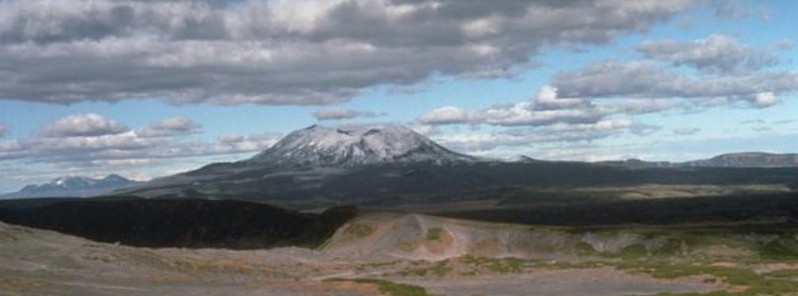Small eruption at Maly Semyachik volcano, the first since 1952, Russia

According to data provided by the Tokyo VAAC, a small eruption took place at Russia's Maly Semychik volcano at 06:40 UTC on July 7, 2017. The last known eruption of this volcano took place in 1952, 65 years ago. The Aviation Color Code remains Green.
The reported ash cloud reached an altitude of just 2.1 km (7 000 feet) above sea level, 600 m (1 970 feet) above the summit. The plume drifted to the southwest at 18 km/h (11 mph).
This was a small eruption but could be a precursor to a larger one. Maly Semychik's hazards are explosive eruptions which produce ash plumes, ashfall, pyroclastic flows and lahars.
KVERT has not issued a Volcano Observatory Notice for Aviation (VONA), and the Aviation Color Code remains Green.
The Global Volcanism Program has no Weekly Reports available for this volcano.
The last known eruption of Maly Semychik took place at its Troitsky Crater in December 1952. It had Volcanic Explosivity Index (VEI) of 2.
This volcano is located 20 km (12.4 miles) west from the coast of the Kronotsky Bay, 15 km (9.32 miles) northeast from Karymsky volcano, and 140 km (87 miles) northeast from Petropavlovsk-Kamchatsky.
Its structure is a 3 km (1.8 miles) long volcanic ridge build up with 3 close stratovolcanoes: Paleo-Semyachik, Meso-Semyachik, and Ceno-Semyachic. Ceno-Semyachic includes Troitsky crater with a thermal Lake.

Geological summary
Maly Semyachik is a compound stratovolcano located in a 10-km-wide (6.2 miles) caldera within the 15 x 20 km (9.3 x 12.4 miles) mid-Pleistocene Stena-Soboliny caldera. Following construction during the late Pleistocene of the Paleo-Semiachik volcano beginning about 20000 years before present (BP), activity migrated to the SW, forming Meso-Semiachik (about 11000 – 9000 BP) and Ceno-Semiachik (about 8000 BP to the present).
An initial stage lasting about 3500 years was dominantly explosive, constructing the present cone. A second stage beginning about 4400 years ago was marked by alternating constructive and destructive processes during which the volcano was destroyed by major explosions and then reconstructed. A crater lake fills the historically active Troitsky Crater, which formed during a large explosive eruption about 400 years ago.
Featured image: The broad Maly Semiachik massif, seen here from the SW on the flanks of Karymsky volcano, is composed of three overlapping stratovolcanoes constructed along a NW-SE line. The volcano was built within two overlapping Pleistocene calderas. The rim of the larger 12-km-wide (7.4 miles) Steena caldera is visible on the far right horizon, but elsewhere its rim is largely buried. The late-Pleistocene to Holocene post-caldera massif almost completely obscures the rim of the inner 7-km-wide (4.3 miles) Maly Semiachik caldera. Credit: USGS / Dan Miller, 1990

Commenting rules and guidelines
We value the thoughts and opinions of our readers and welcome healthy discussions on our website. In order to maintain a respectful and positive community, we ask that all commenters follow these rules:
We reserve the right to remove any comments that violate these rules. By commenting on our website, you agree to abide by these guidelines. Thank you for helping to create a positive and welcoming environment for all.